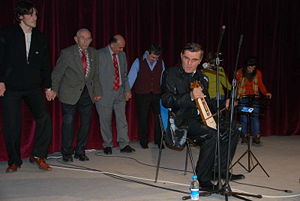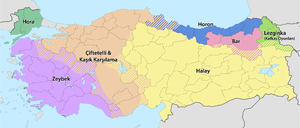- Horon (dance)
-
Music of Greece General topics Ancient • Byzantine • Néo kýma • Polyphonic song Genres Entehno • Dimotika • Hip hop • Laïko • Punk • Rock Specific forms Classical • Nisiotika • Rebetiko • Skiladiko Media and performance Music awards Arion Awards • MAD Video Music Awards • Pop Corn Music Awards Music charts Greek Albums Chart • Foreign Albums Chart • Singles Chart Music festivals Thessaloniki Song Festival Music media Difono • MAD TV (MAD World, Blue) • MTV Greece National anthem "Hymn to Liberty" Regional music Related areas Cyprus Regional styles Aegean Islands • Arcadia • Argos • Crete • Cyclades • Dodecanese Islands • Epirus • Ionian Islands • Lesbos • Macedonia • Peloponnese • Thessaly • Thrace The horon (Greek: Horos [masculine noun, singular form, nominative]), which devires from the Greek word choros (Greek: (ο) Χορός), Turkish: Horon ,is a dance style of Pontus found in the Black Sea region, now modern Turkey. Pontian dance retains the aspects of Greek and Turks dance styles. The dances called Horoi (Greek: Χοροί), singular Horos (Greek: Χορός) meaning literally "dance" in both Ancient (cf. also (η) όρχησις) and modern Greek language, are circular in nature and are each characterized by distinct short steps.
A unique aspect of Pontian dance is the tremoulo (Greek: Τρέμουλο), which is a fast shaking of the upper torso by a turning of the back on its axis. Many Pontian dances are almost identical in steps to Greek dances. Pontian dances also resemble Persian and Middle Eastern dances in that they are not led, with no single leader in the dance formation. This is different from Greek dances but is a widespread aspect of Persian and Middle Eastern dances.
The rapid shoulder and upper body movements from the waist is said to have evolved from the modern Turkish version dating to recent centuries. These movement are said to have derived from the shimmying of the little silver anchovy fish (Turkish: Hamsi) found in mass abundance in the Black Sea, which has worked its way into an inseparable part of northern Anatolian culture. As Pontian populations, were exposed to these dances later, it is said that long sea journeys and merchant exchanges, or perhaps throughout the migration of troops as far away as Ireland en route to the Holy Land were also exposed to these dance styles. It is thought the Irish jig and even its modern version, the River Dance, may have its roots from this exposure.
Horon types
- Omal - (Grk. ομάλ)- meaning calm or Turkish Düz horon
- Tik - (Grk. τικ) - from perpendicular in Turkish Dik
- Argon - (Grk. αργόν) - meaning slow
- Tromakton - (Grk. τρομαχτόν) - meaning fiercely or Tr. Titreme horonu
- So gonaton - (Grk. σο γόνατο) - meaning on the knee
- Langefton - (Grk. λανγκευτόν) - meaning jumping or hopping
- Karslidikon - (Grk. καρσλίδικον) - meaning from Kars
- Diplon - (Grk. διπλόν) - meaning double.
- Dipat or Giavaston - (Grk. διπάτ) - meaning double step or Tr. İkiayak horon
- Ters (from Kioumoush Maten) - (Grk. τερς)- meaning wrong or incorrectly from Turkish term ters
- Ters (from Ak Dag Maten) - (Grk. τερς) - meaning wrong or incorrectly from Akdağmaden town in Yozgat
- Tas - (Grk. τας)
- Trigona (from Trapezounta) - (Grk. τρυγόνα; meaning pigeon in Greek) or Turkish Dirvana
- Trigona (from Matsouka) - (Grk. τρυγόνα)
- Trigona (from Kerasounda) - (Grk. τρυγόνα)
- Seranitsa (from Trapezounta) - (Grk. σερανίτσα) or Laz horon from Laz people of Turkey
- Seranitsa (Sheriana) - (Grk. σερανίτσα)
- Serra - (Grk. σέρρα) - named after the region Serra or Turkish Sıksara horon
- Masher or Maheria (Grk. Μαχαίρια) or Pyrecheios (Grk. πυρήχειος, Turkish Bıçak Oyunu) - ancient Greek dance described by the ancient historian Xenophon meaning sound of fire. In the film, The Addams Family, Gomez dances the Masher.
- Kots - (Grk. κοτς) - meaning heel dance
- Kotsari - (Grk. κότσαρι) - meaning Heel dance or Turkish Koçari an Armenian folk dance
- Almatsouk - (Grk. αλματσούκ)
- Titara (Argyropoli) - (Grk. τίταρα)
- Titara (Kars) - (Grk. τίταρα)
- Giurvalandun - (Grk. γιουρβαλαντούν)
- Samson - (Grk. σαμσόν) - from Samsun
- Etere - (Grk. έτερε)
- Karsilamas - (Grk. καρσιλαμάς) - from Kars or Turkish Karşılama from Turkish Karşılama meaning "face to face"
- Pipilomatena - (Grk. πιπιλομάτενα) - meaning soft eyes
- Tsurtuguzus - (Grk. τσουρτούγουζους)
- Momogera - (Grk. μομόγερα) - meaning immature old men or Turkish Momoyer
- Atsiapat - (Grk. ατσιαπάτ)
- Gemura - (Grk. γέμουρα) - meaning from Gemura from Yomra town, Trabzon
- Diplon Omal - (Grk. διπλόν ομάλ) - meaning double calm
- Kalon Korits - (Grk. καλόν κορίτσ) - meaning good girl
- Kymishanalidikon - (Grk. κιμισχαναλίδικον) - meaning from Gumushane
- Dolme - (Grk. ντολμέ)
- Utsai - (Grk. ούτσαϊ)
- Sarikuz - (Grk. σαρικουζ) from Turkish sarı kız meaning Turkish "blonde girl"
- Siton - (Grk. σιτόν)
- Tamsara (Tamzara) - (Grk. τάμσαρα) from Tamzara town, Giresun
- Tyrfon - (Grk. τυρφόν)
- Fona - (Grk. φόνα)
- Hala-Hala - (Grk. χάλα-χάλα)
- Halai (Halay) - (Grk. χαλάϊ)
External links
Music of Southeastern Europe (the Balkans) By style Pop-folkArabesque ·Chalga · Laïko · Manele · Turbo-folk
Folk musicOtherBy country  Albania ·
Albania ·
 Bosnia and Herzegovina ·
Bosnia and Herzegovina ·  Bulgaria ·
Bulgaria ·  Croatia ·
Croatia ·  Greece ·
Greece ·  Republic of Macedonia ·
Republic of Macedonia ·  Moldova ·
Moldova ·  Montenegro ·
Montenegro ·  Romania ·
Romania ·  Serbia ·
Serbia ·  Slovenia ·
Slovenia ·  Turkey
TurkeyPerformers by country Albania ·Bosnia and Herzegovina · Bulgaria · Croatia · Greece · Republic of Macedonia · Moldova · Montenegro · Romania · Serbia · Slovenia · Turkey
Folk dances Circle dancesOtherBy countryFolk musicians Albanian folk musicians ·Ai Georgis · Angaliastos · Antikristos · Antipatitis · Antistrophe · Atsiapat · Ballos · Byzantine dance · Caryatid's dance · Choros tis palestras · Dance of Zalongo · Dionysiakos · Dipat · Diplos Horos · Endeka Kozanis · Fisouni · Gaitanaki · Gerakina · Hasapiko · Hatzichristos · Horon · Horos · Ikariotikos · Kalamatianó · Kalamatianos · Kalymnikos · Kamilierikos · Kanella · Kangeli · Kapitan Louka · Kastorianos · Katsabadianos · Kerkiraikos · Kinigitos · Kleftes (dance) · Kleistos · Kochari · Koftos · Koutsos · Lafina · Lambri Kamara · Lasithiotikos · Lerikos · Levantinikos · Leventikos · Loulouvikos · Makedonia · Makedonikos antikristos · Makrinitsa dance · Maniatikos · Metsovitikos · Mihanikos · Monodiplos · Mpougatsas · Nisiotika · Nizamikos · Ntames · Ntournerakia · Omal · Omorfoula · O Nikolos · Opa (dance) · Palamakia · Partalos · Pentozali · Pidikhtos · Pizzica · Podaraki · Poustseno · Priniotis · Proskinitos · Pyrrhichios · Rhoditikos · Rodo (dance) · Rougatsiarikos · Rebetiko · Serra · Sirtaki · Sousta · Syrtos · Stamoulo · Tambouras · Tamzara · Tapeinos Horos · Thessalikos · Tis Triandafilias Ta Fila · Tranos Choros · Trata · Trizalis · Tromakton · Tsakonikos · Tsamiko · Tsestos · Tsifteteli · Tsiniaris · Yikna · Zaramo · Zeibekiko · Zervodexios · Zervos · Zonaradiko
Categories:- Greek music
- Greek dances
- Turkish dances
- Greek words and phrases
Wikimedia Foundation. 2010.


